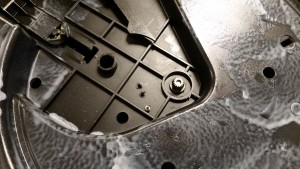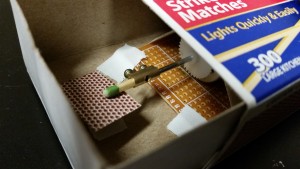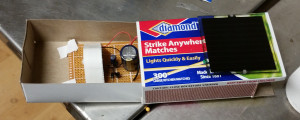For this assignment, our group, consisting of Jared Friedman, Naoki Ishizuka, Yuan Gao and Nicola Carpeggiani, decided to try to create light by spinning a record-player turntable. We theorized that every turntable would have a motor that could be used not only to play a vinyl record but also to generate electricity from kinetic energy.
Our first goal was to maintain the original audio structure of the turntable, to create sounds at the same time as energy while the user was spinning the turntable, but that turned out to be impossible given everything we had to modify to make the turntable work as a generator.
Here’s the process :
We found a used Kenwood kd 29-r belt traction turntable, and we opened it up to check what was inside it and to see if we could use the built-in DC servo motor as a generator.

As we can see in the photo, the DC servo, with the green label on it, is the original motor. This motor drove a belt system, which spun the platter around a fixed spindle in the center. After trying and failing to generate a voltage from its power connections, we decided to completely replace both motor and spindle with a five-wire stepper motor placed with its shaft where the spindle had been. We shimmed it with a piece of silicone sheet we found on the junk shelf to couple the platter with the shaft.

Unfortunately for us, the spindle had been doing a great deal of work stabilizing the motion – without the tightly-engineered shaft and bearing in place, the platter wobbled quite a bit as it spun. We got around this by nudging it into as cooperative a place as we could, and liberally coating all interior surfaces with white lithium grease.

As an output, we used 6 white LEDs. We put them in parallel with a 1-F 5.5V capacitor to collect the unused energy made by the spin of the turntable. While it took quite a bit of time to charge initially (spinning the motor and outputting no light), the capacitor eventually allowed a nicely sustained glow from the LEDs after the user stopped actively spinning.

After that, we covered the platter with another metal plate, which both stabilized things further and stored some excess kinetic energy as a very rudimentary flywheel.
Measurements we took from the system were a peak open circuit voltage of 5.5+ volts, and a short circuit current of around 30 mA, again fluctuating wildly with user input.


The results were not what we had expected at the start, because we originally wanted to also play an LP while spinning/scratching, but in the end, we definitely created light from kinetic energy, and learned a great deal about the difficulties and peculiarities of the process.









